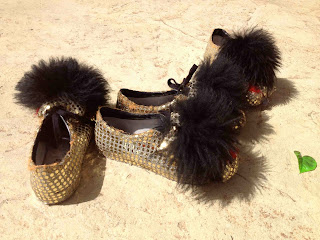 |
| Mr Waqar showing a "learner's carpet" |
I'll admit to total ignorance on the subject of Persian carpets. Completely clueless! So I had a lot to learn and learn I did. We were invited to the shop of Nasim Carpets in Straits Quay for a "carpet talk." And here's some of what I learned:
1) Hand-knotted
carpets can range from 100 knots per square inch to 1,500. Prices rise accordingly.
2) Traditionally,
the first and best thing in a Persian girl’s dowry was a pair of fine carpets.
3) An antique carpet (one over 100 years old),
even one with all the pile worn off, can easily be worth five times the value
of a new one.
· I knew (vaguely) that quality carpets are good investments, just like fine artwork. But I had no idea how good! It depends on the size and quality, of course, but good ones in the Nasim Carpet shop seem to be priced in the low thousands of ringgit, like around RM3,000 and up. But recently they sold a medium-sized silk one that was 50+ years old, with 1,500 knots per square inch. (That's apparently the most knots you can get.) The carpet has the name of the village where it was made knotted into the design. And Mr. Waqar told us he's never seen such a fine one in his ten years of experience with carpets. And guess what it cost! RM 30,000. That's US $10,000 or 778,000 yen. and over 6,000 British pounds. I could never tread on anything that expensive, and apparently the buyer can't either. He's planning to hang it on the wall of his abode somewhere here in Penang.
 |
| Fine silk carpet -- village name on edge |
This was a somewhat humbling experience
for me because I think of myself as pretty artsy-
craftsy and dextrous. But goodness gracious,
how clumsy I was! During the workshop, with
the teacher standing right there by my side helping
I could hardly tie even one knot. I have new respect for Persian carpets and the people who make them for eight, ten or more hours per day. It can take a year or even two to make a particularly fine one. I simply cannot imagine working that hard for that long on just one piece. It makes quilt-making look speedy, which of course it is not!
I was also intrigued by the way they clean these carpets, which they recommend having done every 3 to 5 years. If you live here in Penang, you simply take
it to Nasim Carpets and they send it down to their
KL operation. There, the carpets are put out flat under water and washed with special soft brushes that look
like industrial floor brooms. The detergents are special, too, with special ones being used for the different kinds of carpets - silk, wool or whatever. They dry them flat in the sun, turning them often to avoid fading and to make them dry evenly. Don't try this at home!
The folks at Nasim carpets can appraise and repair Persian (or any) carpets, too. A friend of mine got termites in the Chinese shop house she's refurbishing and those little devils ate a big chunk out of one of her Persian carpets, too. But Mr Waqar says he can have it repaired, though it'll take a bit of time.
They say you learn something new every day, and I learned all kinds of new things about carpets thanks to this workshop. And the lovely spread of drinks and snacks they laid out for us just made the information all the more palatable. You can't learn on an empty stomach, right?
















































